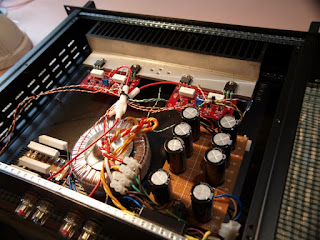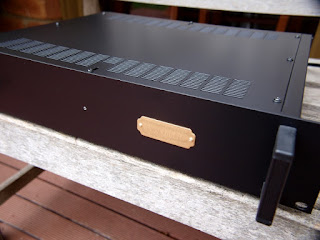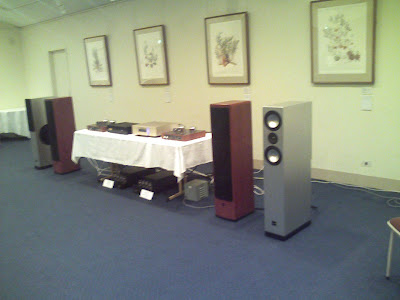Jean Hiraga designed and built an number of symmetric amplifiers which were renowned for purity of sound and natural tone. I love the design philosophy of an amplifier which not only says it is symmetrical but looks symmetrical in circuit and build. These circuit boards I ordered from Croatia and are extremely well made, you guessed it, symmetrical in appearance as well as layout. Jean did state that the boards should not be solder masked and these are. I can only imagine the difference in tone and performance. The mask remains.
What you see in this image is the assembled circuit boards and their related heat sinks (HS). The HS(s) will form a part of the case by employing some heavy aluminium panels, self tapping screws and isolation feet (you must check back to see this). This ensures vibration and resonance issues are controlled. The power supply will be assembled around 60,000uf of filtering, ultra fast diodes, PS snubbing and EMI and RFI reduced, high current deliverable power. The quietness and beauty of this 8 watt audio amplifier lays not in multi-stage, multi-feedback enhanced "more stages are best" design but in its simplicity, ability to deliver and balance of design. Not to mention NO signal caps AT ALL! Not even line caps on the circuit board. Want to find inner musical peace:- Jean Hiraga
Finally this amp is complete and sounding excellent see the new images above. See the retro-thermionic blog for more details.
What you see in this image is the assembled circuit boards and their related heat sinks (HS). The HS(s) will form a part of the case by employing some heavy aluminium panels, self tapping screws and isolation feet (you must check back to see this). This ensures vibration and resonance issues are controlled. The power supply will be assembled around 60,000uf of filtering, ultra fast diodes, PS snubbing and EMI and RFI reduced, high current deliverable power. The quietness and beauty of this 8 watt audio amplifier lays not in multi-stage, multi-feedback enhanced "more stages are best" design but in its simplicity, ability to deliver and balance of design. Not to mention NO signal caps AT ALL! Not even line caps on the circuit board. Want to find inner musical peace:- Jean Hiraga
Finally this amp is complete and sounding excellent see the new images above. See the retro-thermionic blog for more details.








